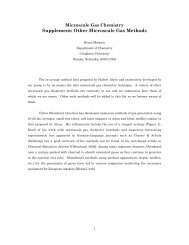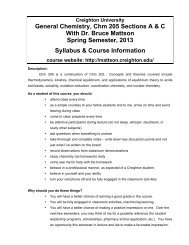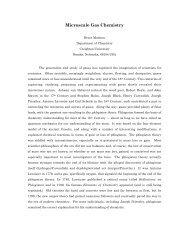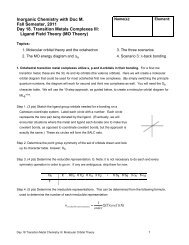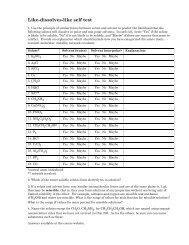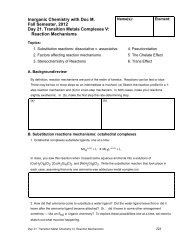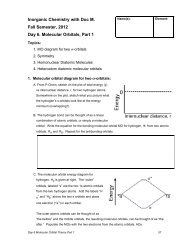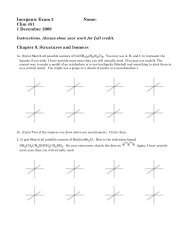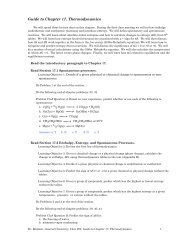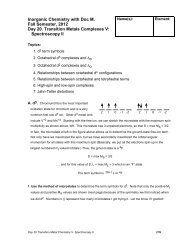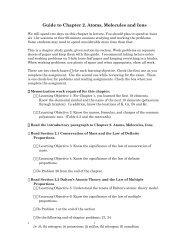Guide to Chapter 5. Periodicity and Atomic Structure ... - Mattson
Guide to Chapter 5. Periodicity and Atomic Structure ... - Mattson
Guide to Chapter 5. Periodicity and Atomic Structure ... - Mattson
Create successful ePaper yourself
Turn your PDF publications into a flip-book with our unique Google optimized e-Paper software.
<strong>Guide</strong> <strong>to</strong> <strong>Chapter</strong> <strong>5.</strong> <strong>Periodicity</strong> <strong>and</strong> A<strong>to</strong>mic <strong>Structure</strong><br />
Answers <strong>to</strong> problem club questions in orange.<br />
We will spend 2 - 3 lecture days on this chapter. In this chapter we will learn more about the structure of the<br />
a<strong>to</strong>m. We will start with a review of electromagnetic radiation. We will discuss the nature of matter, the<br />
deBroglie relationship, <strong>and</strong> the hydrogen spectrum. The most important concept of the first part of this chapter is<br />
the introduction <strong>to</strong> the postulates of quantum mechanics, use of the quantum numbers n <strong>and</strong> l, ml <strong>and</strong> ms. We<br />
will learn the shapes of orbitals, energy diagrams, electronic configurations, ground states, excited states, orbital<br />
box diagrams, dia- <strong>and</strong> paramagnetism, Pauli exclusion principle, electronic configuration <strong>and</strong> the periodic<br />
table. Following that, we will shift <strong>to</strong> some very practical results of quantum mechanics: periodic trends. In this<br />
chapter we will discuss shielding, effective nuclear charge, <strong>and</strong> a<strong>to</strong>mic radii (size). More periodic trends will be<br />
introduced in <strong>Chapter</strong> 6.<br />
This is a chapter study guide, given section-by-section. Work problems on separate sheets of paper <strong>and</strong> keep them<br />
with this guide. When working problems, use plenty of space <strong>and</strong> when appropriate, show all work.<br />
The following useful formulas, equations <strong>and</strong> constants will be given <strong>to</strong> you on the exam:<br />
c = lu DE = hc/l<br />
E = -2.178 x 10 -18 J(1/n 2 ) DE = Ef – Ei = -2.178 x 10 -18 J(1/nf 2 - 1/ni 2 )<br />
1/l = 1.097 x 10 -2 nm -1 (1/nf 2 - 1/ni 2 )<br />
Read the introduc<strong>to</strong>ry paragraph <strong>to</strong> <strong>Chapter</strong> <strong>5.</strong> <strong>Periodicity</strong> <strong>and</strong> A<strong>to</strong>mic <strong>Structure</strong> <strong>and</strong><br />
then read Section <strong>5.</strong>1 Development of the Periodic Table.<br />
Read Section <strong>5.</strong>2 Light <strong>and</strong> Electromagnetic Spectrum.<br />
Learning Objective 1: Know how <strong>to</strong> use the equations for electromagnetic radiation: E = hn, ln = c.<br />
Learning Objective 2: Use the Planck equation <strong>to</strong> determine the energy of light per pho<strong>to</strong>n or per mol of<br />
pho<strong>to</strong>ns.<br />
Learning Objective 3: Use the equation, ln = c, <strong>to</strong> determine frequency, energy, or the wavelength of<br />
light.<br />
Learning Objective 4: Given a list of types of electromagnetic radiation (UV, IR, radio waves, etc.).<br />
Rank them in order of increasing/decreasing energy, wavelength, or frequency.<br />
Do Problem 1-3 at the end of the section.<br />
Do the following end-of-chapter problems: 30, 32, 34, 36<br />
Problem Club Question A. Consider these two electromagnetic waves, shown superimposed on the same<br />
axis. Note that one is a solid line <strong>and</strong> the other is dashed.<br />
(a) Which one represents the higher<br />
energy? Circle: SOLID or DASHED<br />
(b) If these waves represented GREEN<br />
<strong>and</strong> VIOLET, which would be GREEN?<br />
Circle: SOLID or DASHED<br />
(c) Suppose that one of these waves had a<br />
wavelength of 600 nm. Would it be in<br />
the VISIBLE spectrum,<br />
ULTRAVIOLET spectrum or<br />
INFRARED spectrum? Circle your<br />
answer.<br />
(d) Suppose that one of these waves had a wavelength of 440 nm. Calculate the frequency of the wave.<br />
Dr. <strong>Mattson</strong>, General Chemistry, Chm 203, <strong>Guide</strong> <strong>to</strong> <strong>Chapter</strong> <strong>5.</strong> <strong>Periodicity</strong> <strong>and</strong> A<strong>to</strong>mic <strong>Structure</strong> 1
Answer: 6.8 x 10 14 s -1<br />
(e) Convert 440 nm in<strong>to</strong> units of kJ/mol<br />
Answer: 272 kJ/mol<br />
Advice from a former student:<br />
My only advice would be <strong>to</strong> read the chapters before the material is covered in class. Since the class<br />
covers material quickly, it sometimes becomes difficult <strong>to</strong> spend much time on a <strong>to</strong>pic in class, whereas if a person<br />
has read the material prior, the student will have refined his or her questions<br />
Problem Club Question B (ACS-Style). Answer: A<br />
Problem Club Question C (ACS-Style). Answer: C<br />
Read Section <strong>5.</strong>3 Electromagnetic Radiation <strong>and</strong> A<strong>to</strong>mic Spectra.<br />
Learning Objective 5: For the hydrogen a<strong>to</strong>m, determine the energy required (a positive amount) <strong>to</strong><br />
excite an electron from a lower energy shell (more stability) <strong>to</strong> a higher energy shell (less stable). Also<br />
perform the same calculation but the electron drops from a higher energy shell <strong>to</strong> a lower energy shell.<br />
The signs of DE should make sense.<br />
Learning Objective 6: Determine the energy required <strong>to</strong> make the hydrogen a<strong>to</strong>m in<strong>to</strong> the hydrogen ion<br />
(H + ). This is the ionization energy for hydrogen.<br />
Do Problem 4 - 6 at the end of the section.<br />
Do the following end-of-chapter problems: 44, 46, 48<br />
Problem Club Question D. Calculate the wavelength (in nm) for the electronic transition n = 7 æ Æ n = 3<br />
for hydrogen a<strong>to</strong>ms.<br />
Answer: 1005 nm<br />
Problem Club Question E. In the Pfund series, excited electrons relax <strong>to</strong> level n = <strong>5.</strong> (a) What transition (n<br />
= ? <strong>to</strong> n=5) would result in the longest wavelength? The shortest wavelength? (b) Calculate the longest<br />
wavelength possible for a transition of this series.<br />
Answer: (a) n = 6 <strong>to</strong> 5; (b) n = • <strong>to</strong> 5; l = 7460 nm<br />
Problem Club Question F. (a) What is the maximum number of emission lines for<br />
a<strong>to</strong>mic hydrogen that you would expect <strong>to</strong> see in a spectroscope if the only electronic<br />
energy levels involved are those shown at right? [hint there are more than 5] (b)<br />
Which transition would have the least energy? (c) Which one would emit a pho<strong>to</strong>n of<br />
shortest wavelength?<br />
Answer: (a) 15; (b) n = 6 <strong>to</strong> n = 5; (c) n = 6 <strong>to</strong> n = 1<br />
Problem Club Question G. (ACS-Style) Answer: A<br />
Problem Club Question H. (ACS-Style) Answer: D<br />
Problem Club Question I. (ACS-Style) Answer: A<br />
These three sections can be grouped <strong>to</strong>gether:<br />
Read Section <strong>5.</strong>4 Particlelike Properties of Electromagnetic Radiation: The Planck<br />
Equation.<br />
Read Section <strong>5.</strong>5 Wavelike Properties of Matter: The de Broglie Equation.<br />
Read Section <strong>5.</strong>6 Quantum Mechanics <strong>and</strong> the Heisenberg Uncertainty Principle.<br />
Do Problem 7 <strong>and</strong> 8 at the end of Section 4.<br />
Dr. <strong>Mattson</strong>, General Chemistry, Chm 203, <strong>Guide</strong> <strong>to</strong> <strong>Chapter</strong> <strong>5.</strong> <strong>Periodicity</strong> <strong>and</strong> A<strong>to</strong>mic <strong>Structure</strong> 2<br />
n = 6<br />
n = 5<br />
n = 4<br />
n = 3<br />
n = 2<br />
n = 1
Problem Club Question J. Carbon dioxide absorbs energy at a frequency of 2.001 x 10 13 s -1 . (a) Calculate<br />
the wavelength, l of this absorption in nanometers. (b) In what spectral range does this occur? (c) What<br />
is the energy difference in kJ/mol? (Note: "per mole" requires you <strong>to</strong> use Avogadro's number.)<br />
Answer: (a) l = 1.5 x 104 nm (b) infrared (c) 8.0 kJ/mol<br />
Read Section <strong>5.</strong>7 Wave Functions <strong>and</strong> Quantum Numbers.<br />
Learning Objective 7: Be able <strong>to</strong> define each quantum number <strong>and</strong> determine its value. For example,<br />
Given a value for n, what are all the possible values for l? Given a value for l, what are all the possible<br />
values for ml? Given a value for ml, what are all the possible values for ms?<br />
Learning Objective 8: Given a set of quantum numbers n, l, ml, <strong>and</strong> ms, decide whether the values are<br />
valid.<br />
Learning Objective 9: Using a 2-D axis, draw the shapes of the 1s, 2p (all three), <strong>and</strong> 3d (all five) a<strong>to</strong>mic<br />
orbitals.<br />
Learning Objective 10: Define the term node <strong>and</strong> determine the number of nodes that are possible for<br />
a given a<strong>to</strong>mic orbital.<br />
Learning Objective 11: For a given value of n, determine the possible subshells or the number of orbitals<br />
possible (<strong>and</strong> type, s, p, d, etc.) <strong>and</strong> the <strong>to</strong>tal number of electrons that are possible.<br />
Learning Objective 12: For a given value of l, determine the possible orbitals, <strong>and</strong> the <strong>to</strong>tal number of<br />
electrons that are possible.<br />
Learning Objective 13: For any given set of quantum numbers (just n or n <strong>and</strong> l, or n, l, <strong>and</strong> ml, etc.)<br />
determine the maximum number of electrons that can have the designated quantum numbers.<br />
Do Problem 11 - 13 at the end of the section.<br />
Do the following end-of-chapter problems: 50, 56, 58, 60<br />
Problem Club Question K. What are the possible values of l for (a) n = 4; (b) n = 6; (c) n = 2<br />
Answer: (a) l = 0 - 3 (b) l = 0 - 5 (c) l = 0, 1<br />
Problem Club Question L. Which member of each pair of orbitals is lower in energy? (a) 3s or 3p; (b) 1s or<br />
2s; (c) 4p or 4d<br />
Problem Club Question M. Which of the following combinations is not allowed: (a) n = 2 <strong>and</strong> l = 2; (b) n =<br />
4 <strong>and</strong> l = 0; (c) n = 3 <strong>and</strong> l = 2<br />
Answer: (a)<br />
Problem Club Question N. What is (a) the minimum value of n for which l = 4? (b) the maximum value of l<br />
for n = 4? (c) the minimum value of l for n = 4? (d) the maximum value of n for l = 4?<br />
Answer: (a) n = 5 (b) l = 3 (c) l = 0 (d) n = infinity<br />
Problem Club Question O. Give the orbital designation of an electron with each of the following quantum<br />
numbers. The first one is done for you.<br />
electron n l ml ms<br />
7s 7 0 0<br />
4p 4 1 -1<br />
6s 6 0 0<br />
5f 5 3 0<br />
+ 1 /2<br />
Dr. <strong>Mattson</strong>, General Chemistry, Chm 203, <strong>Guide</strong> <strong>to</strong> <strong>Chapter</strong> <strong>5.</strong> <strong>Periodicity</strong> <strong>and</strong> A<strong>to</strong>mic <strong>Structure</strong> 3<br />
- 1 /2<br />
- 1 /2<br />
+ 1 /2<br />
Problem Club Question P. How many orbitals can have these quantum numbers? (a) n = 3, l = 2; (b) n = 4<br />
<strong>and</strong> l = 1 <strong>and</strong> ml = -1; (c) n = 4
Answer: (a) five: m l = 2, 1, 0, -1, -2<br />
(b) just one; these three quantum numbers designate one orbital<br />
(c) max l = 3: therefore m l = 3, 2, 1, 0, -1, -2, -3 for seven orbitals. BUT l could also equal 2, 1 or 0 when<br />
n = 4. This adds 5 + 3 + 1 orbitals for a gr<strong>and</strong> <strong>to</strong>tal of 16 orbitals that could have n = 4.<br />
Problem Club Question Q. (ACS-Style) Answer: B<br />
Problem Club Question R. (ACS-Style) Answer: C<br />
Problem Club Question S. (ACS-Style) Answer: A<br />
Problem Club Question T. (ACS-Style) Answer: A<br />
Read Section <strong>5.</strong>8 The Shape of Orbitals.<br />
Learning Objective 14: Using a 2-D axis, draw the shapes of the 2s, 3s, 4s, etc., or for any of the three<br />
3p, 4p, 5p, etc., a<strong>to</strong>mic orbitals.<br />
Problem Club Question U. What shape type of orbital ( s, p, d, etc) is designates by: (a) n = 2 <strong>and</strong> l = 1; (b) n<br />
= 4 <strong>and</strong> l = 3; (c) n =1 <strong>and</strong> l = 0<br />
Answer: (a) p; (b) f; (c) s<br />
Problem Club Question V. (ACS-Style) Answer: C<br />
Advice from a former student:<br />
Read the book! It helps reinforce the lecture <strong>and</strong> problem solving techniques. Don't expect <strong>to</strong> do well<br />
unless you are willing <strong>to</strong> work one-two hours on chemistry on the week nights. (<strong>and</strong> you gotta catch up on<br />
weekends if you were bombarded with other homework during the week, or else it's difficult when you fall<br />
behind!) Have a clear underst<strong>and</strong>ing that Tests/Quizzes are the only compilation of your final grade, so I<br />
thought it necessary <strong>to</strong> study extra hard for them. In order <strong>to</strong> study well, do all of the assigned book problems <strong>and</strong><br />
the problem clubs; you get better with practice. Go in early <strong>to</strong> class <strong>to</strong> ask questions of the previous night's<br />
homework or just <strong>to</strong> listen <strong>to</strong> others' questions. It's not necessary, but helpful. Don't let the learning objectives fool<br />
you; they were intimidating at first with all the information, but just take them day by day <strong>and</strong> you'll eventually<br />
come <strong>to</strong> underst<strong>and</strong> that everything is tied <strong>to</strong>gether.<br />
Read Section <strong>5.</strong>9 Quantum Mechanics <strong>and</strong> A<strong>to</strong>mic Spectra.<br />
Do Problem 16 at the end of this section.<br />
These five sections can be grouped <strong>to</strong>gether:<br />
Read Section <strong>5.</strong>10 Electron Spin <strong>and</strong> the Pauli Exclusion Principle.<br />
Read Section <strong>5.</strong>11 Orbital Energy Levels in Multielectron A<strong>to</strong>ms.<br />
Read Section <strong>5.</strong>12 Electron Configurations of Multielectron A<strong>to</strong>ms.<br />
Read Section <strong>5.</strong>13 Electron Configurations <strong>and</strong> the Periodic Table.<br />
Read Section <strong>5.</strong>14 Some Anomalous Electron Configurations<br />
Learning Objective 15: Use the periodic table <strong>and</strong> write the ground-state electron configuration<br />
(complete or abbreviated) for a given element <strong>and</strong> then draw the orbital-filling diagram for the valence<br />
electrons..<br />
Learning Objective 16: Use your orbital-filling diagram <strong>and</strong> count the number of unpaired electrons <strong>and</strong><br />
then. <strong>to</strong> determine the magnetism (paramagnetic or diamagnetic) of an element.<br />
Learning Objective 17: For a given element, recognize the difference between its ground-state electron<br />
configuration <strong>and</strong> an excited state electron configuration.<br />
Learning Objective 18: For a given quantum number, n (shell), or find the elements in the periodic table<br />
that have this quantum number.<br />
Learning Objective 19: For a given quantum number, l (subshell), find the groups in the periodic table<br />
that have this quantum number.<br />
Dr. <strong>Mattson</strong>, General Chemistry, Chm 203, <strong>Guide</strong> <strong>to</strong> <strong>Chapter</strong> <strong>5.</strong> <strong>Periodicity</strong> <strong>and</strong> A<strong>to</strong>mic <strong>Structure</strong> 4
Learning Objective 20: When both n <strong>and</strong> l are given (a particular subshell), list all the possible elements<br />
that have these two quantum numbers.<br />
Learning Objective 21: For a given a<strong>to</strong>m or ion, write a set of four quantum numbers for each of the<br />
valence electrons.<br />
Learning Objective 22: Identify the element that begins filling a particular subshell (n <strong>and</strong> l are known)<br />
or completes a given subshell.<br />
Learning Objective 23: Given a generalized electron configuration, for example, ns 2 np 1 , identify the<br />
family of elements with this electron configuration or identify the element with a specifically given<br />
electron configuration, for example, 1s 2 2s 2 2p 4 .<br />
Do Problems 17 – 19 at the end of Section 13.<br />
Do the following end-of-chapter problems: 24, 26, 66, 68, 70, 76, 78<br />
Problem Club Question W. What are the possible values for ml for: (a) l = 2; (b) l = 4; (c) n = 4; (d) n = 1<br />
Answer: (a) –2, -1. 0. +1. +2; (b) –4, –3, –2, -1. 0. +1. +2, +3, +4; (c) –3, –2, -1. 0. +1. +2, +3; (d) 0<br />
Problem Club Question X. Write the ground state electronic configuration for: (a) Cl; (b) Fe; (c) Se; <strong>and</strong> (d)<br />
Si<br />
Answer: a. Cl 1s 2 2s 2 2p 6 3s 2 3p 5<br />
b. Fe 1s 2 2s 2 2p 6 3s 2 3p 6 4s 2 3d 6<br />
c. Se 1s 2 2s 2 2p 6 3s 2 3p 6 4s 2 3d 10 4p 4<br />
d. Si 1s 2 2s 2 2p 6 3s 2 3p 2<br />
Problem Club Question Y. Give the symbol of the element of lowest a<strong>to</strong>mic number whose ground state has<br />
(a) completed d sub-level; (b) three 4d electrons; (c) five 3p electrons; (d) one s electron<br />
Answer:<br />
(a) Cu does if you remember the exception - otherwise the rules predict Zn<br />
(b) Nb<br />
(c) Cl<br />
(d) H<br />
Problem Club Question Z. Classify each as ground state, excited state, or forbidden state: (a) 1s 1 1p 1 ; (b)<br />
1s 2 2s 1 2p 1 ; (c) 1s 1 2s 2 2p 6 ; (d) [Ne] 3s 2 3p 6 4s 2 3d 8 ; (e) [Ne] 3s 2 3p 6 3d 10 ; (f) 1s 2 2s 2 2p 6 2d 8<br />
Answer:<br />
(a) forbidden<br />
(b) excited<br />
(c) excited<br />
(d) ground<br />
(e) excited<br />
(f) forbidden<br />
Problem Club Question AA. Use the box diagrams (orbital diagrams) <strong>to</strong> predict the number of unpaired<br />
electrons are present for each of the following species. Label each as diamagnetic or paramagnetic. (a)<br />
C; (b) Fe; (c) P; (d) Zn; (e) Sb<br />
Answer:<br />
(a) two unpaired electrons - paramagnetic<br />
(b) four unpaired electrons - paramagnetic<br />
(c) three unpaired electrons - paramagnetic<br />
(d) zero unpaired electrons - diamagnetic<br />
(e) three unpaired electrons - paramagnetic<br />
Dr. <strong>Mattson</strong>, General Chemistry, Chm 203, <strong>Guide</strong> <strong>to</strong> <strong>Chapter</strong> <strong>5.</strong> <strong>Periodicity</strong> <strong>and</strong> A<strong>to</strong>mic <strong>Structure</strong> 5
Problem Club Question BB. Assign a set of four quantum numbers <strong>to</strong> (a) the 5s e - in Rb; (b) the 3d e - s in<br />
Ti; (c) all the p-e - s in P<br />
Answer:<br />
(a) n = 5; l = 0; m l = 0; m s = +1/2<br />
(b) two electrons with these quantum numbers (but not the same m l : n = 3; l = 2; m l = -2, -1, 0, +1, +2;<br />
m s = + 1/2<br />
(c) first the SIX 2p electrons: All six have n = 2 <strong>and</strong> l = 1; two have m l = -1 (one with m s = +1/2 <strong>and</strong> one<br />
with m s = -1/2) two have m l = 0 (one with m s = +1/2 <strong>and</strong> one with m s = -1/2) <strong>and</strong> two have m l = +1 (one<br />
with m s = +1/2 <strong>and</strong> one with m s = -1/2). Next, the THREE 3p electrons: All three have n = 3 <strong>and</strong> l = 1;<br />
one has m l = -1 <strong>and</strong> m s = +1/2, one has m l = 0 <strong>and</strong> m s = +1/2 <strong>and</strong> one has m l = +1 <strong>and</strong> m s = +1/2.<br />
Problem Club Question CC. Identify the element with the smallest a<strong>to</strong>mic number that has (a) three delectrons;<br />
(b) a filled p-subshell; (c) n = 3 electrons <strong>and</strong> is diamagnetic<br />
Answer: (a) V; (b) Ne; (c) Mg<br />
Problem Club Question DD. Using “core notation”, give the electron configuration for: (a) Ge <strong>and</strong> (b) Ru<br />
Answer: (a) [Ar] 4s 2 3d 10 4p 2 ; (b) [Kr] 5s 2 4d 6<br />
Problem Club Question EE. Classify each of the following as a ground state, excited state, or an impossible<br />
electron configuration. Circle G, E or I.<br />
(a) 1s 2 2s 2 2p 6 3s 1 G E I (b) 1s 2 2s 2 2p 6 3s 2 3p 6 4s 2 3d 12 G E I<br />
(c) 1s 2 2s 2 2p 6 3d 1 G E I<br />
Problem Club Question FF. Which of the following is/are paramagnetic? (a) Mn; (b) Zn; (c) Sn<br />
Problem Club Question GG. (ACS-Style) Answer: A<br />
Problem Club Question HH. (ACS-Style) Answer: D<br />
Problem Club Question II. (ACS-Style) Answer: B<br />
Problem Club Question JJ. (ACS-Style) Answer: D<br />
Problem Club Question KK. (ACS-Style) Answer: C<br />
Problem Club Question LL. (ACS-Style) Answer: D<br />
Read Section <strong>5.</strong>15 Electron Configurations <strong>and</strong> Periodic Properties: A<strong>to</strong>mic Radii<br />
Learning Objective 24: Discuss/describe the trends found in the periodic table with respect <strong>to</strong> a<strong>to</strong>mic<br />
radii (size).<br />
Learning Objective 25: Draw circles <strong>to</strong> represent the relative sizes of two (or more) a<strong>to</strong>ms.<br />
Do Problem 21 at the end of this section.<br />
Do the following end-of-chapter problems: 28, 54, 84<br />
Problem Club Question MM. Which element of those listed has the largest a<strong>to</strong>mic radius: Ge, As, Se, Sn,<br />
Sb, Te<br />
Dr. <strong>Mattson</strong>, General Chemistry, Chm 203, <strong>Guide</strong> <strong>to</strong> <strong>Chapter</strong> <strong>5.</strong> <strong>Periodicity</strong> <strong>and</strong> A<strong>to</strong>mic <strong>Structure</strong> 6



